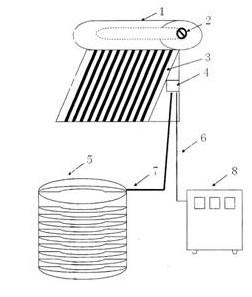
Science and Technology
科技
Solar heat for oil wells
用于油井的太陽熱能
Mirrors in glasshouses…
溫室的反光鏡…...
…can be used to heat stones
…...能用于加熱石頭
THERE is a lot of energy from ancient sunshine stored in the oil that sits below the deserts of Oman.
古代陽光的很多能量儲存于埋藏在阿曼沙漠下的石油里。
There is also a lot of sunshine hitting those deserts today.
如今,還是有很多陽光照射在這些沙漠之上。
A new wrinkle to an established technology should allow some of that current sunshine to be employed to get at more of the ancient stuff.
不過,一項已確定的技術革新應該允許那部分如今的陽光能被用于從古老的原料中提取到更多東西。
Using heat—in the form of steam—to liberate disobligingly thick and gunky oil which would otherwise stay in the ground is nothing new.
運用熱能---以蒸汽的形式---來釋放(放出)不方便使用的濃厚而黏稠狀的石油,否則這些石油會留在地下,這沒什么新鮮的。
Such enhanced-recovery techniques date back to the 1950s and 40% of California's oil production now depends on steaming subterranean rocks in this way.
這類提高的采收石油技術可以追溯到20世紀50年代。現如今,40%的加州石油產品就是以這種方式依賴熱氣騰騰的地下巖石生產而成。
The steam, however, is made by burning other fossil fuels—normally natural gas—and because heating rock takes a lot of steam, making that steam takes a lot of money.
然而,通過燃燒其它化石燃料來生產蒸汽---一般為天然氣---而因為加熱巖石需要很多蒸汽,所以生產蒸汽花費很大。
It also adds to the oil's climate footprint.
它還增加石油的(氣候變化)的碳排放量。
The amount of gas used means that a barrel of Californian heavy oil gives the stuff from Canada's tar sands a run for its money in terms of associated greenhouse-gas emissions.
根據相關的溫室氣體排放量,天然氣的耗費量意味著每桶加州重油竭盡全力打敗了加拿大瀝青砂巖中提取的原油。
GlassPoint, a small Californian company, thinks it can make steam for oil recovery more cleanly and cheaply by using sunshine to do the heating.
加州的一家小公司---玻璃點太陽能公司認為,通過使用陽光來加熱,它能為采油生產更清潔和更便宜的蒸汽。
This sounds surprising.
這聽起來令人感到意外。
Solar-thermal power stations, which employ mirrors to concentrate sunlight on boilers and thus raise steam to generate electricity by turning turbines, are far from cheap compared with gas-fired stations.
太陽能熱發電站利用反光鏡將太陽光集中到鍋爐上,因而提升蒸汽轉動渦輪機來產電,與燃氣站相比一點也不便宜。
But solar-thermal electricity faces exacting challenges.
然而,太陽能熱發電面臨嚴峻的挑戰。
To feed a turbine you need particularly pure steam, which can be a problem if you are in a desert.
為了給渦輪機提供特別需要的純蒸汽,如果在沙漠里的話,這可能是個問題。
And to get the most out of the system you need the steam to be both very hot indeed and available in copious amounts.
而且為了從這個系統中得到最多,確實需要非常高溫的蒸汽而且要用的量很大。
Oil wells, GlassPoint's founders noticed, are far less demanding consumers in these respects.
玻璃點太陽能公司的創始人注意到,在這些方面,油井是要求少的多的消費者(消耗者)。
The steam used can be comparatively dirty.Nor does it have to be infernally hot.
相比之下,使用的蒸汽可以臟些,溫度也不需要過高。
And even a small amount of it, added to an existing gas-based recovery process, can make a useful contribution.
而且,甚至添加少量的蒸汽到現有的以天然氣為基礎的采油過程也能產生作用。
There are, though, disadvantages to having to work in an oilfield.
雖然,如果必須在油田運用蒸汽的話,確實有些不利條件。
People building solar-thermal power stations prefer sites low in dust.
人們喜歡在粉塵量低的位置建造太陽能熱發電站。
Those serving the oil industry must go where the rigs are, however dusty and mucky the air.
無論空氣塵土多大,多么骯臟,為石油工業服務的人們必須跟隨鉆井走。
GlassPoint seems to have found a neat solution to this: it puts its mirrors indoors. Greenhouses are easy to buy, quick to erect and, thanks to off-the-shelf kit designed for the purpose, simple to keep clean, too.
玻璃點太陽能公司似乎已經為此找到了一套干凈利落的方案:把反光鏡放在室內。由于為建溫室目的而設計現成的成套用品,人們很容易購買到溫室,很快就能建造起來,而且保持清潔也很簡單。
Moreover, sheltering the mirrors from the wind allows those mirrors to be a lot lighter, making them both cheap to build and ship, and easier to turn in order to follow the sun.
此外,為保護反光鏡免受風的侵蝕,準許這些反光鏡重量要輕的多,使得它們既建造便宜也容易運輸,而且為了跟進太陽而更容易轉向。
GlassPoint's boss, Rod MacGregor, thinks that taking capital costs and the lifetime of the plant into account his firm can produce steam at $3.78 per million British thermal units (btu), which is $3.58 a gigajoule.
玻璃點太陽能公司的老板羅德?麥格雷戈(Rod MacGregor)認為,考慮到工廠的資金成本和歷史,他的公司能產生蒸汽每百萬英(制)熱單位(BTU)3.78美元,這是每千兆焦耳3.58美元。
Steam from gas comes in at $5.79 per million btu.
天然氣加熱的蒸汽達到每百萬英(制)熱單位(BTU)5.79美元。
A pilot project in California, he says, has been producing steam as intended since the beginning of the year.
他說,自年初以來,加州一個實驗項目已經產生了預期的蒸汽。
And the company has now signed a deal with Petroleum Development Oman for 7 megawatts of plant—a 16,000-square-metre greenhouse providing some 57 billion btu of steam a year.
而且該公司現在已經與阿曼石油開發公司簽署了7兆瓦工廠的協議---一個16000平方米的溫室,每年大約提供570億百萬英(制)熱單位(BTU)的蒸汽。
If it pans out, the technology could spread fast.
如果這個實驗項目發展開來的話,那么這項技術可能會傳播很快。
Mr MacGregor expects Oman to be using 200 trillion btu of steam a year for oil recovery by 2015.
麥格雷戈先生預計,到2015年為止,阿曼石油開發公司每年可以使用200萬億每百萬英(制)熱單位(BTU)蒸汽來開采石油。
Not all of that steam could be solar, but a system which used high-pressure solar steam during the day and low-pressure gas-generated steam by night, to keep the pipes hot, might get 80% of its power from the sun.
并非所有的蒸汽來自太陽能,而是來自一個系統。白天,這個系統使用高壓太陽蒸汽,而晚上使用低壓天然氣產生的蒸汽,保持管道熱乎,或許80%能量可從太陽光獲得。
That would free up a lot of gas for export—or for turning into petrochemicals.
這將可以得到很多天然氣用于出口---或用于轉變成石油化學制品。
Enhanced oil recovery currently uses a quite remarkable amount of energy: 1.7 quadrillion btu of gas around the world every year, according to GlassPoint.
目前,提高石油開采使用相當大的能量:根據玻璃點太陽能公司所述,每年,世界各地需要使用1.7×1015每百萬英(制)熱單位(BTU)的天然氣。
Not all of that is in sunny places, but there are many deserts besides Oman's that have oil beneath them.
并不是所有天然氣都在陽光充足的地方,但是,除了阿曼沙漠下面有石油外,許多沙漠下都有石油。
The paradoxical possibility, then, is that solar-thermal technology might end up producing a lot more oil than electricity in the years to come.
然而,自相矛盾的可能性是,在未來幾年里,太陽能熱技術最終可能生產許多石油,而不是電。











